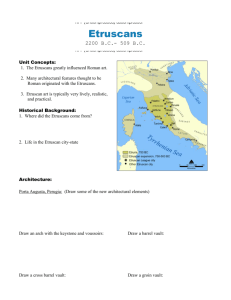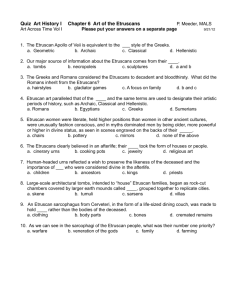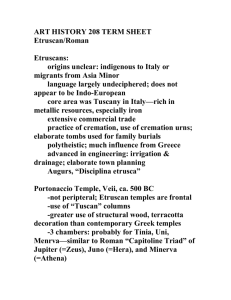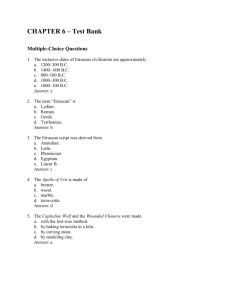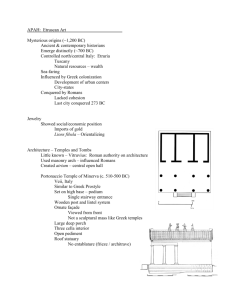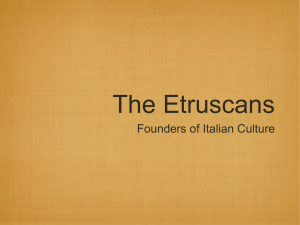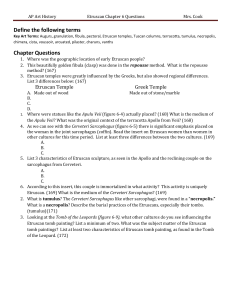Who let the animals out? Changing modes in Etruscan mirror
advertisement
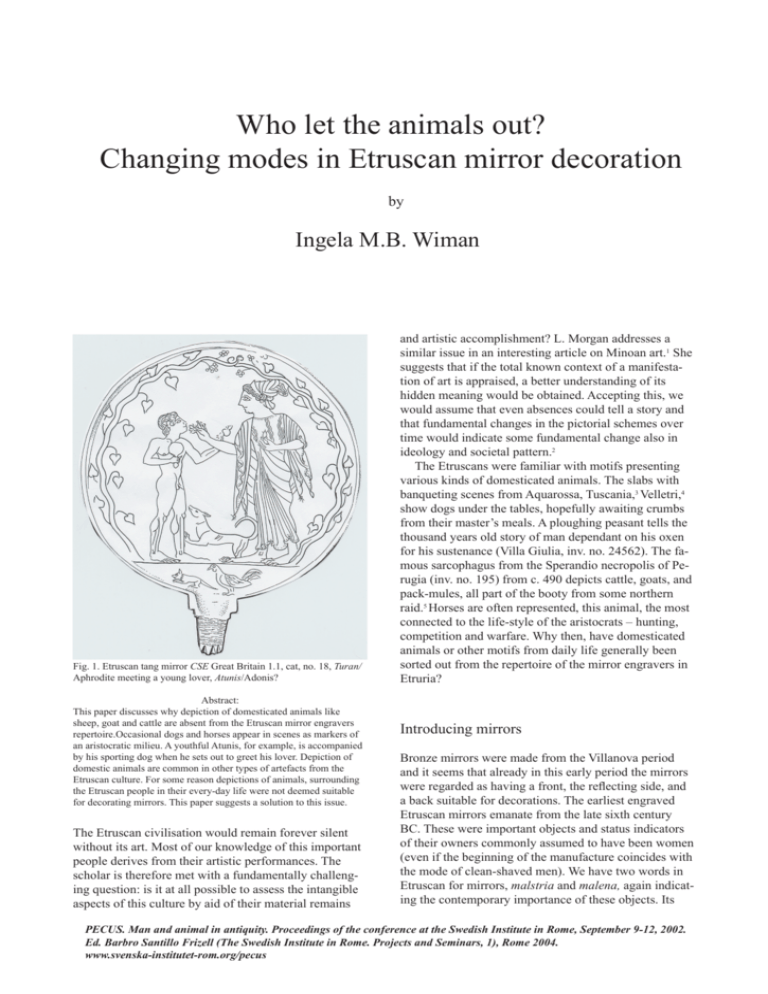
Who let the animals out? Changing modes in Etruscan mirror decoration by Ingela M.B. Wiman Fig. 1. Etruscan tang mirror CSE Great Britain 1.1, cat, no. 18, Turan/ Aphrodite meeting a young lover, Atunis/Adonis? Abstract: This paper discusses why depiction of domesticated animals like sheep, goat and cattle are absent from the Etruscan mirror engravers repertoire.Occasional dogs and horses appear in scenes as markers of an aristocratic milieu. A youthful Atunis, for example, is accompanied by his sporting dog when he sets out to greet his lover. Depiction of domestic animals are common in other types of artefacts from the Etruscan culture. For some reason depictions of animals, surrounding the Etruscan people in their every-day life were not deemed suitable for decorating mirrors. This paper suggests a solution to this issue. The Etruscan civilisation would remain forever silent without its art. Most of our knowledge of this important people derives from their artistic performances. The scholar is therefore met with a fundamentally challenging question: is it at all possible to assess the intangible aspects of this culture by aid of their material remains and artistic accomplishment? L. Morgan addresses a similar issue in an interesting article on Minoan art.1 She suggests that if the total known context of a manifestation of art is appraised, a better understanding of its hidden meaning would be obtained. Accepting this, we would assume that even absences could tell a story and that fundamental changes in the pictorial schemes over time would indicate some fundamental change also in ideology and societal pattern.2 The Etruscans were familiar with motifs presenting various kinds of domesticated animals. The slabs with banqueting scenes from Aquarossa, Tuscania,3 Velletri,4 show dogs under the tables, hopefully awaiting crumbs from their master’s meals. A ploughing peasant tells the thousand years old story of man dependant on his oxen for his sustenance (Villa Giulia, inv. no. 24562). The famous sarcophagus from the Sperandio necropolis of Perugia (inv. no. 195) from c. 490 depicts cattle, goats, and pack-mules, all part of the booty from some northern raid.5 Horses are often represented, this animal, the most connected to the life-style of the aristocrats – hunting, competition and warfare. Why then, have domesticated animals or other motifs from daily life generally been sorted out from the repertoire of the mirror engravers in Etruria? Introducing mirrors Bronze mirrors were made from the Villanova period and it seems that already in this early period the mirrors were regarded as having a front, the reflecting side, and a back suitable for decorations. The earliest engraved Etruscan mirrors emanate from the late sixth century BC. These were important objects and status indicators of their owners commonly assumed to have been women (even if the beginning of the manufacture coincides with the mode of clean-shaved men). We have two words in Etruscan for mirrors, malstria and malena, again indicating the contemporary importance of these objects. Its PECUS. Man and animal in antiquity. Proceedings of the conference at the Swedish Institute in Rome, September 9-12, 2002. Ed. Barbro Santillo Frizell (The Swedish Institute in Rome. Projects and Seminars, 1), Rome 2004. www.svenska-institutet-rom.org/pecus 296 Ingela M.B. Wiman Fig. 2. Etruscan tang mirror CSE U.S.A. 3, cat. no. 14, showing Pele/ Peleus astound by the beauty of a naked Thethis/Thetis preparing for their coming wedding. importance for present-days scholars is immense, giving evidence of letters, spelling, language, literary taste, penetration of Greek cultural influences, dress-styles, gods, and so on. The suggestion that the mirrors were intended for the tomb and therefore did carry motifs appropriate to the after-life does not apply. Mirrors were mended and repolished in antiquity and therefore used by living women.6 In fact, the motifs must have represented something vital to these women – these Greek gods, refined myths or Homeric tales of early Etruscan times, later joined by the Etruscan divinities and heroes from the ending fourth century BC. Presenting some Archaic and Classic mirrors As stated above, we have no genre scenes presenting domestic animals in their own right on the chief motif of mirrors. In the Archaic or Classic periods, however, when the mirror engravers mostly depict stories from Greek mythology, there is an abundant animal life in the mirror exergues when they are present. It must be admitted that such exergue decoration is rather unusual but when they appear they are always related to the main motif. Look at our first specimen, a mirror published in CSE,7 (Great Britain 1.1, cat. no. 18), Turan meeting a young or, simply human, lover (Fig. 1). He is smaller than she is and perhaps intends to present her with the mirror he holds in his right hand and the flower or pomegranate in his left. He cheered by his dog, a suitable attribute for an aristocrat or a hunter. She is bigger, older or just divine. She is holding a flower to his face. The coding of this motif is probably just. It can only be a divine actor that is made in a bigger scale than the mortal presented in a common arena, or a younger man facing an adult woman i.e. Turan with some lover, possibly Atunis, a common motif on mirrors. The main scene is Greek and presented in a clear and unambiguous way Fig. 3. Etruscan tang mirror, British Museum mirror inv. no. 626 which shows the dressing of the bride Malavisch surrounded by three attendants and Turan. From E. Gerhard, Etruskische Spiegel II, pl. 213. according to the standard formula. Than look at the accompanying scene on the exergue, a hen chasing a cat or small dog! Here is an Etruscan mind at work with the humorous undertones that is so typical in the Etruscan dealings with the Greek art. The hunt is reversed on the main scene, an older woman chasing a youngster, and on the exergue, a hen chasing a predator. Normally the reverse would be expected. The next example is from the classical period, (CSE U.S.A. cat. no. 14), showing Pele astound by the beauty of a naked Thethis preparing for their coming wedding (Fig. 2). The identification of the characters and the meaning of the motif are clear from the accompanying inscriptions. Here is not the place for a detailed discussion on the possible Greek prototypes for Etruscan motifs on mirrors. A similar vivid scene, however, is not known from the preserved Greek art but might have existed.8 Still, this motif has the distinguished Etruscan character of facetious mocking with the tales of the Greeks. The little griffin puppy reclining on the exergue of this mirror also exemplifies this phenomenon. Seemingly sleeping, he opens a cunning eye to the spectator – you and I both know what will be the outcome of this union! The following example also shows a wedding-to-be, but an Etruscan one, the British Museum (hereafter cited as BM) mirror inv. no. 626, dated to around 350 BC (Fig. 3). It shows the dressing of the bride Malavisch surrounded by three attendants and the goddess of sexual love, Turan. Another coupling takes place on the exergue, a cock and hen in amorous encounter predicting the objective of the dressing scene above. Although the main motif is highly serene, an amusing and rather equivocal quality is added by the exergue decoration. Who let the animals out? Fig. 4. Etruscan tang mirror CSE, U.S.A. 3, cat. no. 15. It shows Uthste/Odusseus and Velparun/Elpenor are flanking Cerca/Circe who is in the process of transforming one of Odysseus men into a pig. The last example from the classical period is a mirror from the Metroplitan museum, (CSE, U.S.A. 3, cat. no. 15), Uthste and Velparun are flanking Cerca who is in the process of transforming one of Odysseus men into a pig (Fig. 4). The unfortunate man has only one remaining human limb, his left leg; the rest is all “hoggish”, complete with a curl on its tail. In this case the mocking exergue decoration has been moved upwards as part of the main design. The mirror is dated 350-300 BC. From the later half of the fourth century large tang mirrors with elaborate motifs in three parts are created, the three-parted disc group mirrors.9 It is clear that the engraving masters of these were inspired by the large vases made in South-Italian cities like Tarentum and Paestum between 350-325 BC, often with theatrical motifs. The members of the aristocratic or mercantile elite who bought these mirrors knew well the myths of the Attic drama. Knowledge of the Attic theatre was a token of erudition by the Greeks in Hellenistic times.10 The Etruscans were, surely, also interested of possessing an air of erudition. A closer look at such a crater, the volute crater from Tarentum attributed to the Dareios painter now in (BM inv. no. 1956.12-26.1) with a motif from Euripides Hippolytus, or the bell crater from Paestum , BM (inv. no. 1917.12-10.1) with a motif from Aeschylus, Eumenides, one finds that the three-parted structure of the vases is reflected on the mirror discs. Furthermore, the elaborate and decorative style of these vases, with intricate dress details and elegantly formed coiffures, as well as many small in-fill ornaments, are directly copied by the mirror masters.11 These mirrors 297 Fig. 5. An Etruscan handle mirror from British Museum inv. no. 633. It depicts the famous Etruscan brothers Vibennae standing in ambush for Cacu and the boy Artile. A satyr overlooks the event from a cliff above. Courtesy by the Trustees of the British Museum. display ornamentally rich and elaborated motifs witnessing the good knowledge of the Etruscan engraver of Greek myths, sometimes of a very sophisticated nature. But, as has been pointed out by L. Bonfante among others: “The Etruscans often produced their own versions of Greek stories with a different cast of characters and a different slant from the Greek account.”12 This fact has to be considered in discussing the role of Greek myths in the Etruscan society. R. Buxton emphasises that myths had a functional aspect only in the society in which they were performed.13 The freedom used by the late Classical Etruscans in dealing with Greek myths might suggest that their prime function in the receiving society were as entertaining stories. Another explanation is also possible. The Etruscans used these Greek myths freely in combination with their own mythological cosmos from this period onwards. It is therefore possible to suggest that at this time, the Etruscan had embraced the Hellenic culture to the extent of thinking of it as their own and considered themselves in no way inferior to the Greeks as citizens of a Hellenised world at the time. The changing formula of the later Etruscan motifs As stated above, a new “spirit” is discernible in the mirror motifs from the later Etruscan period. The beginning of the third century is notable for the invasion of Etruscan divinities and heroes in the universe of the Etruscan mirror. From this time on, domestic animals as 298 Ingela M.B. Wiman and Laran17 as bystanders while Zeus is attended by the Etruscan midwife Thalna. All three are pure Etruscan participants in this typical Greek myth. The last example to be discussed here is the splendid mirror from the Metropolitan, CSE, U.S.A. 3, cat. no. 11 (Fig. 6). This is a motif that echoes the lost play Prometeus Vinctus by Aeschylus and it is dated to 280 BC. The left-hand figure is Esplace/Asclepius who dress the wounds of Prumathe/Prometeus. Asclepius makes here his only appearance in Etruscan art. This fact alone indicates that this motif is modelled on a Greek prototype. Discussion Fig. 6. An Etruscan handle mirror, CSE, U.S.A. 3, cat. no. 11. This shows a motif that echoes the lost play Prometeus Vinctus by Aeschylus. The left-hand figure is Esplace/Asclepius who dress the wounds of Prumathe/Prometeus in the middle with Hercle/Heracles and Menrfa/ Athena as bystanders. well as exergues disappear from the mirror discs as the tang mirror is gradually abandoned in favour of mirrors fabricated in one piece, the handle mirror. A final state of tang mirror manufacture shows a naked winged female deity, generally presumed to be the somewhat elusive Etruscan goddess called Lasa.14 CSE, Belgique 1, cat. no. 21, shows such a motif . These mirrors depict only floral pictorial elements as additions to the main motif.15 A handle mirror from the BM (inv. no. 633) can exemplify this new trend in the mirror manufacture. It depicts the famous Etruscan brothers Vibennae standing in ambush for Cacu and the boy Artile (Fig. 5). A satyr overlooks the scene from a cliff above. Contemporary sarcophagi from Vulci, Siena and Volterra16 also exhibit this purely Etruscan motif. Another Etruscan deity also enters the art arena at about this time, the death demon Vanth. She is present on sarcophagi and in tomb paintings but also on some mirrors as i.e. the famous BM mirror cat. no. 625. She stands here with her torch overlooking the event when Achilleus raises the severed head of Troilus, his dead horse in a crumpled mass before the feet of the victorious hero. As we have seen from the Troilus mirror above, Greek motifs are still highly favoured but often with inclusions of pure Etruscan gods or heroes. An engraving master may use a common Greek motif like the birth of Athena and mix it with Etruscan characters among the Greek gods. The BM mirror cat. no. 696, has Marishysta An interesting trait of these late mirrors is that they evoke the Greek theatre, not only in the main motifs. The surrounding wreath of spicy leaves formed like a garland sometimes have pinecone endings.18 Such garlands were, among other things, used to decorate festive podiums.19 J. Beazley noticing the small rectangular ornaments of the spiky garlands, calls the garland bakchos and names the casings, accordingly, bakchos rings: “I ought to have observed there, when speaking of the favourite border in these mirrors [spiky garland group] that rings or slides were not used on ‘Bakchoi’ only, but also for securing wreaths or festoons…”.20 Most handle mirrors end in an animal head of a ram or a hind.21 L. Bonfante has made the observation that the handles hind’s heads look exactly like the head of the hind accompanying the priestess of Dionysus on a sarcophagus in the museum of Barbarano Romano, Viterbo.22 All these traits seem to imply a Dionysian connection. The ram, however, is not an iconographical attribute of Dionysus. The god pictured in the guise of a ram was Apollo Karneios. 23 A coin with this motif have been found in South-Italy dated to 425-390 BC.24 Another interesting complication emerges in the fact that handle mirrors with hind’s head endings often display a laurel wreath surrounding the main motif.25 The laurel is an attribute of Apollo, while the ram’s head handles are preferred for the spiky garland, “Dionysian”, mirror group.26 The interesting conclusion emerges that, perhaps, the ram’s head has been mistaken for what is really a buck’s head, the he-goat that accompanies satyrs in Dionysian scenes i.e. Capra rather than Pecus. Various species of the Capra family have horns that are turned backwards behind the ears. The horns of the mirror animals, however, look very thick like those of a ram. The domesticated species of goat normally have thinner horns. The detailed rendering of the locks on the reverse side of the heads might refer to the goats “beard” hanging from its chin (Fig. 7). It is impossible to state anything conclusive about this issue. The two gods, however, Fufluns and Apulu/Aplu in Etruscan, are closely connected and both have definite affinities to the belle arti and the theatre of the Greeks. So why did the Etruscan interest in the Greek theatre increase so dramatically in the first half of the third century BC? It is fair to assume that the impetus for the Who let the animals out? 299 Fig. 7. Shows the handles of Fis 6 and 7 above. Is it a representation of a ram’s or a buck’s head? later Etruscan mirror motifs derive from South-Italian vase paintings but Attic vase-painting disappears around 320, and the South-Italian soon after. 27 The engraving master who fabricated the Metropolitan museum mirror (Fig. 6), with the Prometheus vinctus motif, sometimes between 280-270 BC must have had other prototypes than the ones his predecessors made use of. 28 Scholars often consider the contemporary Hellenistic painting when looking for prototypes to Etruscan art.29 J.J. Pollitt gives a colourful description of some traits he finds particularly characteristic for the Hellenistic period, among them a theatrical mentality that he finds so predominant that sometimes life was perceived as a reflection of the theatre.30 The Etruscans surely shared also this mentality with their southern Greek neighbours. The prototype for motifs like Prometheus vinctus may well have been some Hellenistic painting or paintings on theatrical posters used to announce a dramatic performance to be given in a South-Italian city or, suggestively, an Etruscan one. Even if we never find a theatrical mask engraved on a mirror, the Etruscan word for this object, Phersu, was transformed to the Latin persona. The Latin histrio was derived from the Etruscan name for an actor, ister. Telling facts, indeed, of the Etruscan interest in the theatre. Conclusive remarks We have seen that the Etruscan engravers in Archaic and Classical times sometimes used domestic animals as elaboration or complements to the main motifs. It is fair to assume that also this trait was borrowed from Greek black- or red figured vases along with the main motifs, even if these small in-fill ornaments were treated with a distinct Etruscan touch of humour. In the later Etruscan period such elaboration disappears. Even if a new interest of depicting clearly indigenous divinities and heroes is remarkable for the period, we never find Etruscan every-day scenes or depictions of domestic animals on the engraved motifs of the mirrors. We have to move to the handle endings to find one such animal, the ram’s or, possibly, buck’s head, as discussed above. It is perhaps in the theatrical implication of this period that we can find the first step in solving the puzzle of these absences. Later Etruscan artists knew their presumptive customers interest in everything Greek at the time when the inevitable process of Romanization had begun. The French sociologist, Pierre Bourdieu, discusses the social uses of cultural phenomena. He points out that people invest not only in means of money but 300 Ingela M.B. Wiman also in prestigious “ cultural goods” as part of a social strategy.31 In a time when leading citizens of Etruria found themselves to be dominated by a powerful but “uncivilised” neighbour they invested in their cultural heritage. An Etruscan upper-class woman, rich enough to buy an expensive bronze mirror, demonstrated by means of this purchase that she was part of a superior class and a citizen in a Hellenic world, however dominated. That is why she wanted it to be decorated with pictures that reflected this connection. Oxen, pigs, sheep, or any agricultural motif were not valid as symbols of her socio-cultural investments. January 23, 2003 Ingela M.B. Wiman Department of Classics Göteborg University Box 200 S-405 30 Göteborg Ingela.Wiman@class.gu.se ________ *Acknowledgements I benefited, as always, from fruitful discussions with Prof. Larissa Bonfante, Dr. Michael Petterson and my distinguished colleagues at the Dept. of Classics in Göteborg. The participants of the Pecus-conference in Rome, September 11-15, 2002 contributed much to my knowledge and interest of the relation between man and animal. The personnel of the Swedish Institute in Rome are thanked for all the scientific generosity and kindness provided. My participation in the Conference was funded by the Royal Society for Sciences and Letters in Gothenburg for which I am very grateful. 1 Morgan 1985. 2 Wiman 2000-1, 112, discusses more thoroughly the importance of different subsystems of any given society and the interaction between these subsystems within the larger cultural system as a unit. 3 Strandberg Olofsson 1994. 4 Cf. for instance the picture in The Etruscans cat.no. 166, 595. 5 For a picture see The Etruscans cat no. 171, 596. Wiman 1990, 35-38. Corpus Speculorum Etruscorum, hereafter cited as CSE. 8 Bonfante 1997, 48 listing two vases with Thetis and Peleus, a Faliscan volute crater and an Attic pelike, but “composition and treatment are different” i.e. from our mirror. 9 Wiman 1990, 117-119. 10 Zanker 1995, 195. 11 Wiman 1990, 117-119. 12 Bonfante 1997, 51. 13 Buxton 1994, 14-17. 14 Rallo 1974. 15 This motif is also depicted on the later handle mirrors and is the last to be engraved on mirrors alongside the motif of two standing men facing each other, the standing dioscuri group, Wiman 1990, 156-221. 16 Nielsen 1993, 324. 17 LIMC II (1984), 498 s.v. Laran (E. Simon). 18 For an extensive discussion of these mirrors, see Wiman 1990, 192-221. 19 Bordenache Battaglia 1979, cat. No. 7 displays such a festive podium decorated with spiky garlands in a triumphal scene. 20 Beazley 1947, 131. 21 Wiman 1990, 11f. 22 Larissa Bonfante, personal correspondance, Jan. 6, 2003. 23 “This specific Dorian way of representing Apollo Karneios probably refers to a theriomorphic conception of the god as a ram…To this…can be added the depiction of ram’s horns on coins representing Apollo Karneios”, Pettersson 1992, 61-62. 24 LIMC II (1984), 226 s.v. Apollon, no. 337 (G. KokkorouAlewras). 25 Wiman 1990, 113-117. 26 Wiman 1990, 201. 27 Trendall & Webster 1971; Trendall 1989. 28 The difficulty of dating the later Etruscan mirrors is conspicuous and treated Höckmann 1987; see also Wiman 1990, 204. The Metropolitan museum mirror discussed above (Fig. 7), however, is dated by L. Bonfante, both from the content of the tomb group connected with it and the style of dress and jewellery to 280-270 BC, thus a good point of reference for the dating of this mirror group. 29 Among many others, see Dohrn 1972 and Boardman 1994, 263 and 269. 30 Pollitt 1986, 1-16. 31 Bourdieu 1976, 448-461. 6 7 References Beazley 1947 J. D. Beazley, Etruscan vase painting, Oxford 1947. Boardman 1994 J. Boardman, The diffusion of Classical art in Antiquity, London 1994. Bonfante 1997 L. Bonfante, CSE, U.S.A. 3, New York, Rome 1997. Bordenache Battaglia 1979 G. Bordeache Battaglia, Le ciste Prenestine 1, Rome 1979. Bourdieu 1979 P. Bourdieu, La distinction. Critique social du jugement, Paris 1979. Buxton 1994 R. Buxton, Imaginary Greece. The context of mythology, Cambridge 1994. Dohrn 1972 T. Dohrm, Die Ficoronische Ciste in der Villa Giulia in Rom, Berlin 1972. Höckmann 1987 U. Höckmann, ‘Die Datierung der Hellenistisch-Etruskischen Griffspiegel des 2. Jahrhunderts v. Chr.’, JdI 102, 247-289. Morgan 1995 L. Morgan, ‘Idea, idiom and iconography’, in L’iconographie minoenne. Actes de la Table Ronde d’Athènes, (BCH suppl. 11), Paris 1985, . Who let the animals out? Nielsen 1993 301 M. Nielsen, ’Cultural orientations in Etruria in the Hellenistic period: Greek myths and local motifs on Volterran urn reliefs’ in Aspects of Hellenism in Italy: Towards a cultural unity?(=Acta Hyperborea 5), Copenhagen 1993, . Pettersson 1992 M. Pettersson, Cults of Apollo at Sparta. The Hyakinthia, the Gymnopaidiai and the Karneia (ActaAth8°, 12), Stockholm 1992. Politt 1986 J.J. Politt, Art in the Hellenistic Age, Cambridge University Press 1986. Rallo 1974 A. Rallo, Lasa. Iconographia e esegesi, Forence 1974. Strandberg Olofsson 1994 M. Strandberg Olofsson, ’Some interpretational aspects of the Acquarossa/Tuscania mould-made terracottas and their architectural context’, Opus Mixtum. Essays in ancient art and society (ActaRom 8°, 21), Stockhom 1994, . The Etruscans The Etruscans (ed.) M. Torelli, Exhibition catalogue, Venice 2000. Trendall & Webster 1971 A. D. Trendall & T. B. L. Webster, Illustrations of Greek drama, Edinburgh 1971. Trendall 1989 A. D. Trendall, Red figure vases of South Italy and Sicily. A handbook, New York 1989. Wiman 1990 I.M.B. Wiman, Malstria – Malena. Metals and motifs in Etruscan mirror craft (SIMA 91), Jonsered 1990. Wiman 2000-2001 I.M.B. Wiman, ‘Man and nature in Etruria’, OpRom 25-26, 2000-2001, 109-124. Zanker 1995 P. Zanker, The mask of Socrates: the image of the intellectual in antiquity, Berkeley, Calif. 1995.
